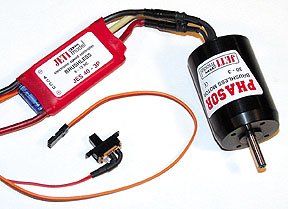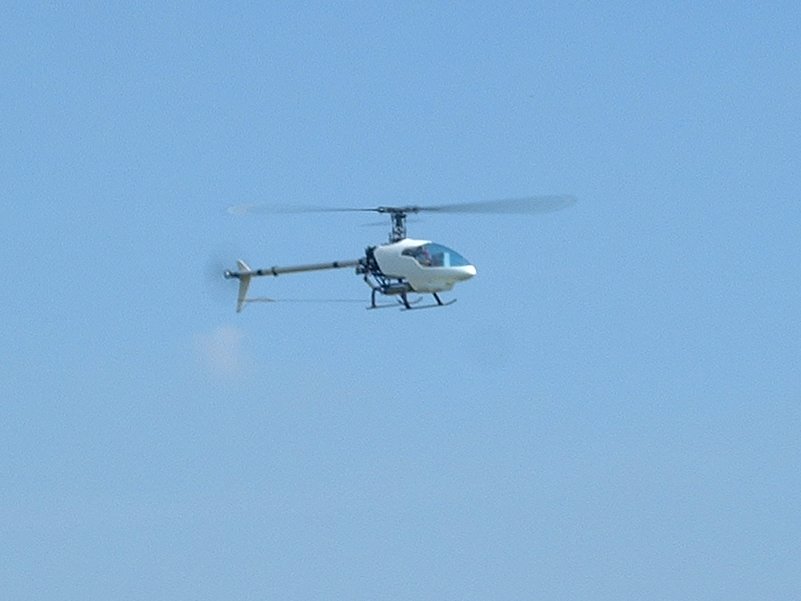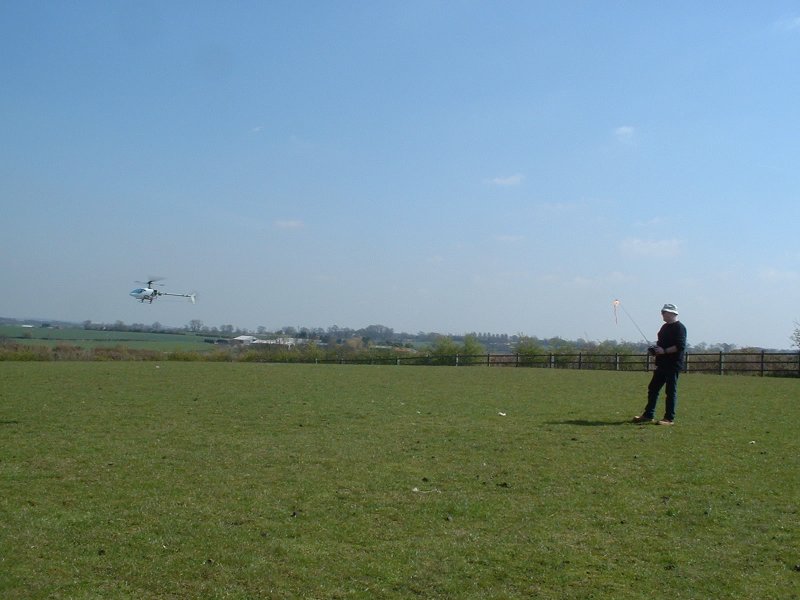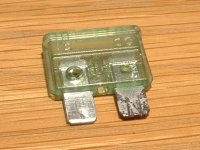
home aircraft books history links old news quotes soft sounds weather
early electric power gliders helicopter indoor technology future
eco8 hornet

My 1st heli.
July 2000 I finally decided I could afford it.
I wanted a helicopter without the noise and mess i.e. electric.
Searching the web, there seemed to be a few conversions, but this was purpose
designed/built for electric.
Incidentally I found a whole lot more when I searched for "hubi schrauber" -
the germans are a bit keen.
I also wanted to make use of the technology I already had for the aerojet e.g.
buggy size motors, speed controllers, chargers etc.
It also offers the option of using a standard 4 channel Tx.
It is actually quite a nice shape too.
I was aware of the latest mini helis like the piccolo and hornet, but these are
a bit tricky for a beginner.
A bit of a culture shock for someone used to balsa bashing.
The box contained lots of numbered bags with an unfeasibly large number of
mysteriously shaped bits of plastic, ball races and screws.
The instructions contained dire warnings about not opening the bags until
needed, together with nice explosion drawings showing the eventual location of
the bits.
There really is very little to "build" in the conventional sense.
It's more a case of screwing/gluing bits onto the chassis.
I briefly considered using the mechanical mixer bits with a standard Tx and
quickly discarded the idea.
The extra slop in all those linkages is bound to make it more tricky to fly.
Arguing that it would be useful for other things, I splashed out (another)
£200 on a futaba FF8 computer Tx.
This allows 3 servos to directly attach to and control the swash plate.
I bought 4x hitec HS81MG servos to cope with the high loads.
I decided to go straight for a "state of the art" CSM ICG540
heading lock piezo gyro, reasoning that I would need all the help I could
get.
I immediately discarded the hardwood and balsa rotor blades (needing static and dynamic balancing) in favour of a carbon fibre set from mscomposit.
I bought the standard entry level "sport" motor and started with a fleet
speed controller, blade fuse/holder and 7x cell 8.4V 2000mAh.
The main power cells are hung between the undercarriage legs to keep the c of g
low.
The tail boom is a very light aluminium tube concealing a kevlar toothed
belt with a 90 degree twist - very efficient, apparently.
I initially sited the tail servo near the front for balance, with a traditional
control snake taped to the boom.
I fitted a standard hitec 8 channel Rx.
This actually has every connector used.
4x to each servo.
1x to speed controller.
1x to control gyro gain/mode.
1x power in.
1x power out to led battery state monitor.
Siting some of the components is a bit optional.
In the end I decided to locate the Rx high at the rear to stay away from the
speed controller, which is adjacent to the motor.
That left only the front for the gyro where I had to hack away part of the
chassis to make it fit.
To ensure continuity of control even after main power failure, I fitted a separate 700mAh Rx pack at the front for balance.
Here are 2 later photos, showing various upgrades.
The eco8 heli with the canopy off.
Left to right:
tail rotor pitch servo
hitec Rx
main power connector
tail rotor lay shaft
3x swash plate collective/cyclic pitch servos hitec HS81MG
30A blade fuse/holder
chocolate block power connector
Jeti Phasor 30/3 motor
JES 40-3P opto controller
700mAh Rx pack
CSM ICG 540 piezo gyro
10x cell 12V 2400mAh power pack

...and on the other side.
Left to right
10x cell 12V 2400mAh power pack
CSM ICG 540 piezo gyro
700mAh Rx pack
JES 40-3P opto controller
Jeti Phasor 30/3 motor
3x swash plate collective/cyclic pitch servos hitec HS81MG
battery state monitor
hitec Rx
power switch
main power connector
tail rotor pitch servo
August 2000 I tethered the centre of the training undercarriage to a board
in the garden and fired it up to get the feel of the controls.
A bit of "heading lock" drift was noticeable, presumably as the electronics
warmed up, as it seeemed to get better after a while.
Useful time to get used to using the left hand to keep the height and tail
under control.
Soon released it and started hovering close to the ground.
Found out about ground effect, which causes it to go skittering off in any
direction it get s started in.
Best to leap into the air, as soon as you're confident with what comes next.
The tail oscillated horribly, although overall the heading was "locked".
October I put a bigger pinion (13 teeth was 10) on the
motor, to get more head speed.
Managed to crash the rotors into the grass when trying to avoid the edge of the
garden - no apparent damage.
Took it up to Wolston for more space.
Several tail in hover sessions in a moderate wind.
Eventually overconfident, I got it above me with the power failing and had to
run away when I could not get it to penetrate into wind.
£60 damage including a new set of main rotors, fly bar, tail boom and
undercarriage.
December 2000 flew it at 1 of the indoor flight sessions.
Also got someone to fly it for me.
It was noticeably underpowered, even at the start of the charge.
Moved up to 8x cell 9.6V 2400 mAh power.
Quite a bit better.
February 2001 flew it indoor.
Quite a nice tail in hover.
Told that it was too big for indoor.
At this point I decided to get a hornet mini heli after seeing
them flying.
June 2001 having learnt a great deal from the hornet, I came back to the
eco8.
Reprogramming the pitch curve so I can alter the max pitch without changing the
zero point.
July 2001 filmed the tail in hover in the garden.

August 2001 flying at Wolston the sports motor gradually died, probably the
windings shorting out.
Decided to go straight to brushless technology.
September 2001.
Decided on the Jeti Phasor 30/3 motor and JES 40-3P
Opto Controller.
The start is a bit sudden, causing the main rotor blades to get left behind
differentially, causing a horribly vibratory start.
I couldn't think how to sort this at 1st, but eventually realised that all I
needed to do was give the rotor a little spin by hand before starting the motor
- works fine.
Brushless motors are meant for direct drive, so have a larger 5mm shaft,
requiring a new pinion.
I started off with a 17.

November 2001.
Flew it for the 1st time with the new motor at an indoor session.
Plenty of power and duration now.
February 2002.
Started using the FMS flight sim, which is great for getting practice time
in.
March 2002.
New motor pinion 21 to get more head speed.
Tail in hover in garden.
August 2002.
Flew it at Wolston.
September 2002.
Again at Wolston, including nose in hover, despite moderate wind.
Removed the training undercarriage and tail stiffener, and flew it in the
garden (tail in only).
April 2003.
After the winter steadily improving with the hornet, I got the eco8 out again.
Also June, July.
August 2003.
Now quite comfortable with nose in hover, but only from a nose in take off.
September 2003.
Managed 180 degree turns from nose in to tail in.
March 2004.
After almost 4 years, I thought it was about time I learned to really fly this
thing.
Bought some new Tx and Rx crystals for the new helis only field.
April 2004.
Started putting some time in at wolston.
Now can flip it between tail in and nose comfortably.
Also upgraded to a GP3300 power pack.
May 2004.
Getting a bit more confident.
Throwing it round more e.g. left to right traverses.
Still not comfortable with side on hover, and the occasional heavy landing.
June 2004.
Crashed it.
I wasn't trying anything clever - just a nose in hover, some way out.
Seemed to lose power, and sank to the ground quite fast, causing a big boom
strike.
June 2004.
Taking the opportunity to upgrade some of the parts.
Aluminium and carbon chassis, carbon boom, white grp blades.
Overtaken by modern technology, with smaller things performing much
better.
I also don't like the energy present in those rotor blades whizzing about
Still intact, so could be flown again.
| span | area | mass | loading |

Ikarus Eco8 and MS Composit Hornet electric helicopters.
Indoor flying session at Coventry sports centre 2001.

Ikarus Eco8 electric helicopter. Indoor flying session at a Coventry school
November 10 2001.
1st flight with new Jeti Phasor brushless sensorless motor/controller.
Photo taken by Lee/Jo with their digital camera.

TBA


Mark flying the eco8 heli at wolston 2004.04.09.


The eco8 crashed at a club meeting in June 2004 and the main fuse (corroded but not blown) that may have been the reason for loss of power resulting in a fast descent and heavy landing, resulting a in a boom strike.